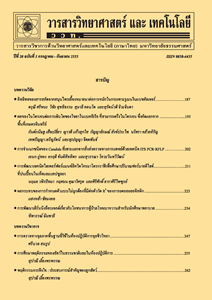อิทธิพลของการใช้ปอเทืองร่วมกับมูลโคต่อการผลิตและคุณค่าทางโภชนะของหญ้าเนเปียร์ปากช่อง 1
Main Article Content
Abstract
Abstract
The purpose of this research was to investigate the influence of Crotalaria Juncea and cattle manure on the production and nutritive value of Napier grass Pakchong 1. Randomized complete block design (RCBD) was experimented with Napier grass Pakchong 1. Planted in a plot of 1 x 4 meters, the experiment was divided into 4 treatments of 4 replications, each with 14 holes and each with 3 breed pieces. The method takes 45 days as follows: Process 1 the soil of Nong Khwang Higher Education Operation Center does not improve the soil. Process 2 the Soil of the Center was improved with 2 ton per rai of cattle manure. Process 3 the soil of the Center was improved with Crotalaria Juncea and 2 ton per rai of cattle manure. Process 4 the soil of the Center was improved with Crotalaria Juncea and 2.4 ton per rai of cattle manure. The results showed that height of the tree, number of shoots per clump and number of leaves per plant grown in 45 days was statistically significantly different (p < 0.01). By the using of Crotalaria Juncea and 2.4 ton per rai of cattle manure affects most growth, secondary is the use of Crotalaria Juncea and 2 ton per rai of cattle manure and the use of cattle manure alone is not different from not using. Total production per process, weight before drying and weight gain after drying were significantly different (p < 0.01). By the using of Crotalaria Juncea and 2.4 ton per rai of cattle manure works the best result. But every nutritional process are protein percentage, fat, fiber, ash and moisture content were not significantly different (p > 0.05)
Keywords: Crotalaria juncea; cattle manure; production; nutritive value; Napier Pakchong 1
Article Details
References
[2] ชุมพล คนศิลป์, บุญล้อม หะนิลณี และอดุลย์ ศรีสุพรรณ, 2539, การทดสอบพืชปุ๋ยสดบางชนิดเพื่อใช้บำรุงดินไร่, รายงานผลงานวิจัย, ฝ่ายวิชาการสำนักงานพัฒนาที่ดินเขต 5 กรมพัฒนาที่ดิน กระทรวงเกษตรและสหกรณ์, กรุงเทพฯ.
[3] สุภาพร จันรุ่งเรือง, โสฬส แซ่ลิ้ม, สิรินภา ชินอ่อน, ทศนัศว์ รัตนแก้ว, ชัยสิทธิ์ วัฒนาวังจงสุข และนิเวศน์ ผาสุกศรี, 2550, พืชปุ๋ยสด...ฟื้นฟูปฐพีสู่วิถีเศรษฐกิจพอเพียง, ศูนย์อำนวยการส่งเสริมเกษตรอินทรีย์ สำนักเทคโนโลยีชีวภาพทางดิน กรมพัฒนาที่ดิน กระทรวงเกษตรและสหกรณ์, กรุงเทพฯ.
[4] ศิริลักษณ์ วงส์พิเชษฐ, มปป., การเพิ่มมูลค่าของเสียจากการเลี้ยงสัตว์, เอกสารประกอบการสอน โมดูลที่ 8, สาขาวิชาเกษตรศาสตร์และสหกรณ์ มหาวิทยาลัยสุโขทัยธรรมาธิราช, นนทบุรี.
[5] AOAC, 1990, Official Methods of Analysis of Association of Official Analytical Chemists, 15th Ed., The Association, Arlington, VA.
[6] ชื่นจิต แก้วกัญญา, ชยานันท์ หนองใหญ่ และอนุรักษ์ เรียมแสน, 2558, การใช้พืชตระกูลถั่วในระบบการปลูกพืชเพื่อเพิ่มผลผลิตมันสำปะหลังที่ปลูกบนดินลูกรัง, แก่นเกษตร 43(ฉบับพิเศษ 1): 635-642.
[7] อมรรัตน์ ซุยถัง, พงศ์พันธุ์ เธียรหิรัญ และกฤษณา รุ่งโรจน์นวณิชย์, 2557, การปลูกพืชปุ๋ยสดเป็นพืชแซมเพื่อปรับปรุงดินและเพิ่มผลผลิตข้าวโพดหวาน, P-ST005, การประชุมเสนอผลงานวิจัยระดับบัณฑิตศึกษา มหาวิทยาลัย สุโขทัยธรรมาธิราช ครั้งที่ 4, นนทบุรี, 11 น.
[8] พนมพร วรรณประเสริฐ, ดุสิต อธินุวัฒน์ และชนัญ ผลประไพ, 2556, ผลของการใช้ปอเทืองร่วมกับปุ๋ยคอกในการผลิตคะน้าอินทรีย์, Thai J. Sci. Technol. 2(2): 115-124.
[9] ทวีศักดิ์ ทองไฝ, 2559, การศึกษาผลผลิตและองค์ประกอบทางเคมีของหญ้าอาหารสัตว์ 4 ชนิด ในจังหวัดสงขลา, การประชุมวิชาการ มหาวิทยาลัยราชภัฏภูเก็ต ครั้งที่ 6, ภูเก็ต.
[10] สาราญ วิจิตรพันธ์ และพรชัย ล้อวิลัย, 2554, อิทธิพลของการตัดที่มีต่อผลผลิตและคุณค่าทางโภชนะของหญ้าเนเปียร์ยักษ์ภายใต้การให้น้ำชลประทาน, ว.วิจัย มข. 16(3): 215-224.
[11] ศุภสิทธิ์ สิทธิธาพานิช, พรทิพย์ ศรีมงคล, วิมลนันทน์ กันเกตุ และนุชนภางค์ สุวรรณเทน, 2557, อิทธิพลของปุ๋ยพืชสดต่อผลผลิตและการดูดใช้ธาตุไนโตรเจนของข้าวที่ปลูกในดินลูกรัง, ว.วิทย์. กษ. 45(2)(พิเศษ): 613-616.


